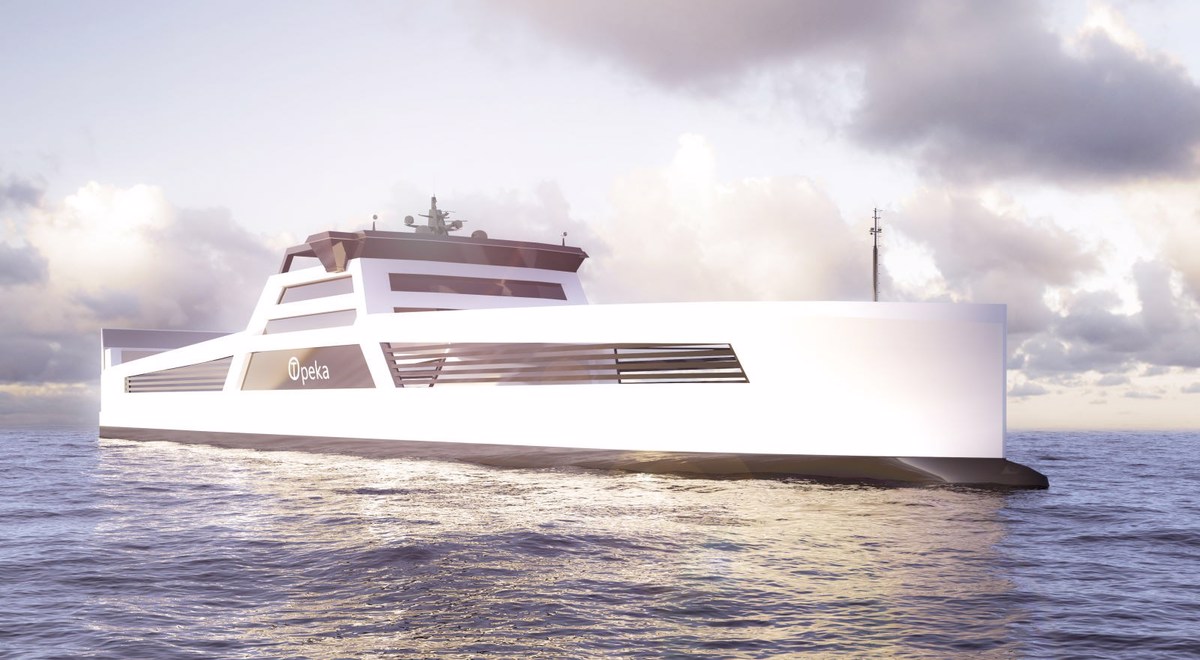Strong indication that a new energy economy is emerging - IEA head
The shipping sector offers one of the largest opportunities to cut fossil fuel consumption and deliver emissions savings, the IEA said in its latest annual Global Hydrogen Review.

PHOTO: Design for Topeka's hydrogen-powered vessel for Enova. Wilhelmsen
Considering existing policies and measures, the International Energy Agency (IEA) estimates hydrogen demand to reach 115 million mt/year by 2030. This could potentially rise to 130 million mt/year if governments across the world deliver on their climate pledges.
In its annual Global Hydrogen Review report, the IEA said that meeting governments’ climate pledges would require annual low-emission hydrogen production of 34 million mt/year by 2030. It also called the need for a sixfold increase in global manufacturing capacity of electrolysers by 2025 to support hydrogen’s encouraging case.
Electrolysers split water into oxygen and, more importantly, hydrogen.
IEA executive director Fatih Birol believes hydrogen will play a critical role in the green transition. Hydrogen will reach its full potential through technological advancements, refinements to regulations and increased demand, he said.
Governments need to implement concrete policies to remove regulatory barriers and support shovel-ready projects, said Birol, as the energy watchdog laid out certain policy recommendations to encourage investment in low-emissions hydrogen.
- Move from announcements to policy implementation: Governments need to implement policies to reduce risk and improve the economic feasibility of low-emission hydrogen projects.
- Raise ambitions for demand creation in key applications: Focus on sectors where hydrogen can both support decarbonisation and reduce dependency on fossil fuels, from sectors such as heavy industry, heavy-duty road transport and shipping.
- Identify opportunities for hydrogen infrastructure and ensure that short-term actions align with long-term plans: As governments address immediate energy needs today, it is nonetheless important to carefully consider how new gas-related infrastructure may potentially support the future development of hydrogen in the context of climate ambitions.
- Intensify international cooperation for hydrogen trade: Development of international markets for low-emission hydrogen will strongly depend on effective international cooperation.
- Remove regulatory barriers: Actors involved in a hydrogen market need clear rules but applying rigid regulatory principles in a nascent market could discourage investments. This should apply also to enabling infrastructure projects, including renewable generation capacities and CO2 transport and storage.
Hydrogen, ammonia and methanol – holy trinity of the shipping sector
Hydrogen and its derivatives, such as ammonia and synthetic methanol, will be in particularly high demand from the shipping sector, according to the IEA, with more than 100 pilot and demonstration projects already underway. Major companies have forged strategic alliances to secure these fuel supplies. The maritime sector has also shown increasing interest in hydrogen-derived synthetic fuels.
In terms of statistics, the report noted that the “Getting to Zero Coalition,” which is working to accelerate the transition to zero-emission shipping, is undertaking several pilot and demonstration projects, out of which 45 focus on hydrogen, 40 on ammonia, and 25 on methanol as a shipping fuel. The majority of hydrogen projects focus on small vessels, ammonia projects on large vessels, and methanol projects split between both.
Out of the total global orderbook for newbuild ships, 66 orders have been placed for ammonia-ready vessels, three for hydrogen-ready vessels and five for methanol-fuelled vessels in the first half of 2022.
- Hydrogen as shipping fuel: The IEA believes that specific guidelines could better facilitate wider adoption of hydrogen and hydrogen-based fuels in international shipping.
- Ammonia as shipping fuel: The report noted that governments and industry are working towards ammonia-powered vessels, where ammonia appears better suited than hydrogen for large, deep-sea, long-distance vessels.
- Methanol as shipping fuel: Methanol has a higher technology readiness level than hydrogen or ammonia technologies for shipping. There are 56 methanol vessels in operation or on order (including dual-fuel). As a hydrocarbon fuel, it has a high energy density that makes it well suited for long-distance vessels.
The IEA said that in the foreseable future, synthetic methanol made from renewable electrolytic hydrogen and sustainable CO2 sources has a competitive edge over low-emission ammonia. But bio-methanol could be held back from scaling by limited availability of biogenic or direct air capture CO2 feedstock. Synthetic methane faces similar feedstock constraints as a sustainable fuel for shipping.
By Konica Bhatt
Please get in touch with comments or additional info to news@engine.online





